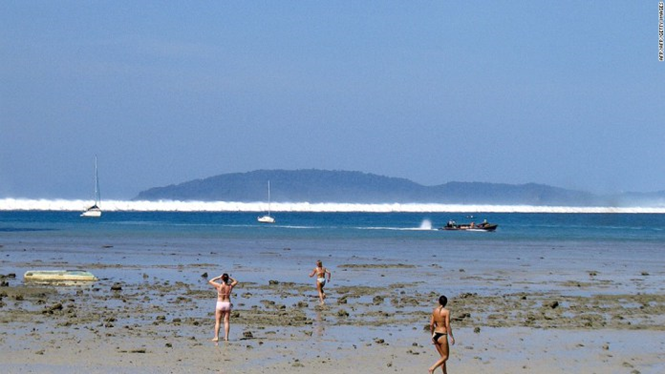 In the photo: tourists observe the arrival of the first tsunami wave in Phuket, Thailand, on 26 December 2004. In the foreground, the effects of the initial water withdrawal.
In the photo: tourists observe the arrival of the first tsunami wave in Phuket, Thailand, on 26 December 2004. In the foreground, the effects of the initial water withdrawal.
A tsunami is a series of waves caused by the sudden displacement of large masses of rock or sediment. This displacement can be caused by earthquakes, underwater landslides or volcanic eruptions. Although it is a rather rare possibility, even the impact of a meteorite on the sea surface can generate a tsunami.
Earthquakes are the most frequent cause of tsunamis (about eighty per cent of the total) and can have particularly catastrophic dimensions and effects when they occur along a subduction zone, an area where the tectonic plates flow under each other, with the oceanic plate sinking down to the earth's mantle.
In addition to earthquakes linked to the subduction phenomenon, we must add those caused by crustal faults, characterised by the two fault blocks moving in different ways in relation to each other. Depending on the type of movement, we distinguish between normal faults, reverse faults and strike-slip faults.
When the energy released by the earthquakes is large enough (magnitude greater than 5.5) there may be a deformation of the seabed, which then transfers to the entire water column above. If the displacement of the fault blocks has a vertical component, i.e. one of the two blocks rises or falls with respect to the other (as in normal and reverse faults), the overlying water mass will also rise on one side of the fault line and fall on the other side.
The temporary lowering of one of the fault blocks can cause a negative wave, and near the coast the sea can recede for hundreds of metres, before the arrival of a large wave. This is a typical phenomenon of large tsunamis, and was also observed during the great Sumatra tsunami of 2004.
FROM THE VIDEO ON INGVTERREMOTI
Tsunami waves are completely different from waves generated by wind or weather disturbances, because the movement of the sea affects the entire water column from the bottom to the surface. The kinetic energy transported by a tsunami is, in fact, much greater than the waves caused by the wind, which only move the water of the most superficial layers. To better understand the force of a tsunami wave, it is useful to clarify that the current generated by a tsunami, even if it is only a few dozen centimetres high, is able to knock down an adult man and to drag him into the sea, or to move a heavy car for tens of metres.After the initial rise, the water mass expands horizontally due to the force of gravity, generating the tsunami waves. Just as occurs when you throw a rock into the water, the waves continue to propagate for a certain period of time. Tsunamis can last for several hours, and the first wave arriving on the coast is not always the biggest and most destructive one.
VIDEO TSUNAMI BODRUM/KOS 20.07.2017
The events which took place in the Mediterranean over the last twenty years are all linked to crustal faults. The Boumerdès/Zemmouri (Algeria) earthquake of magnitude 6.8 on 21 May 2003, which caused more than 2000 deaths, was generated by a reverse crustal fault which triggered a tsunami whose waves spread throughout the western Mediterranean, causing considerable material damage in the ports of the Balearic Islands in Spain. More recently, the Bodrum/Kos earthquake (on the border between Turkey and Greece), which occurred on 20 July 2017 with magnitude 6.6, was generated by a normal crustal fault. Similarly, the Messina earthquake of 1908 was also generated by a crustal (extensional) fault located in the same-named Strait.
...


